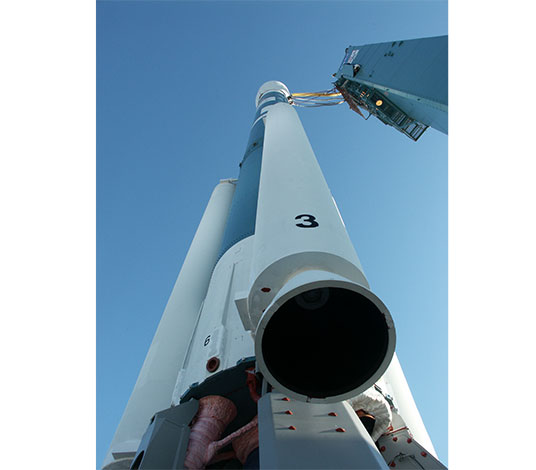Ask NASA Climate | June 25, 2014, 10:46 PDT
How many scientists does it take to launch a NASA satellite into space?

NASA's carbon dioxide-tracking satellite, Orbiting Carbon Observatory-2 (OCO-2), will be launched into orbit via a United Launch Alliance (ULA) Delta II rocket on July 1 at 2:56 a.m. PT. Credit: Steve Greenberg
How many scientists, engineers and support crew does it take to launch a rocket with a NASA satellite into space? More than it takes to screw in a light bulb, that’s for sure. A big team collaborated on NASA’s Orbiting Carbon Observatory-2 (OCO-2)—a custom built, hand-crafted, experimental instrument—and prepared it for launch into orbit. I mean, it's not like you can actually buy a shiny new "prefab" science satellite off a store shelf.
As the July 1 launch creeps closer, the OCO-2 science team has been almost too busy to breathe. I caught Deputy Project Scientist Annmarie Eldering rushing between meetings to prepare for a Discovery News Earth-themed Google hangout. She was too busy to talk.

If you were a fly buzzing through the halls of JPL, this is the sort of interesting information you might be surprised to learn about carbon dioxide (CO2) and NASA’s newest OCO-2 observatory:
- As of now, there are between 70-150 ground-based stations around the world that measure CO2. At each of those stations, very precise measurements are made that tell us what’s happening at that individual location. Taken together, they give an average measurement for Earth’s whole atmosphere.
- The reason NASA even has an OCO-2 mission is that we would never have enough ground-based CO2 measurements to figure out all the human processes that emit CO2 plus all the natural processes that both emit and absorb it, so we need to measure CO2 from space.
- This new observatory will give us details about where, as one scientist put it, “every single CO2 molecule is going."
- Human activity produces more CO2 (currently 35-40 billion tons annually) than any other greenhouse gas. Therefore, it can be said that CO2 is the principal anthropogenic greenhouse gas driving climate change.
- Once the CO2 gets into Earth’s atmosphere, the only way for it to leave is by being absorbed into the ocean or taken in by plants. The CO2 that stays in the Earth's atmosphere may stay there a thousand years.
- The fact that CO2 stays in the atmosphere such a long time means that it’s mixed into the atmosphere really well, which makes measuring small variations very difficult. That's why NASA’s OCO-2 instruments must be extremely precise.
- To design instruments to be sensitive enough to measure CO2, scientists borrowed ideas from the practice of measuring the thermal radiation that shines through the clouds on Venus' dim night side.
- OCO-2 sits atop a Delta II rocket, which is scheduled to launch on July 1 at 2:56 a.m. PT. There is only a 30-second launch window.
- A number of weather issues could cause a postponement. These include thunderstorms and lightening, anvil clouds or conditions that cause hail. Everyone is excitedly checking the weather; atmospheric scientists love weather. The forecast for Vandenberg Air Force Base on the California coast (where the launch will take place) is clear and calm. (Yay!)
- Fifty-two minutes after launch, separation of the OCO-2 observatory from the launch vehicle second stage will occur. Three minutes after that, the observatory’s solar panels will deploy and the satellite will have enough juice to send us a 'Hi, I’m powered on' message.
- Once we begin to receive detailed data from OCO-2, NASA scientists will be extremely careful to compare and validate (double-check) the data from space against ground-based measurements before it's released to the public. This information is crucial and, at NASA, it’s our job to ensure that what we report is accurate and verified.
This weekend, I’ll be heading up the coast to tweet, post and blog about the launch. Follow along at these links:
NASA Climate Change Facebook page
NASA's Global Climate Change website
Thanks for your comments,
Laura
OCO-2 is part of NASA's Earth Right Now campaign, a series of five Earth science missions that will be launched into space in the same year, opening new and improved remote eyes to monitor our changing planet.
